There are versions of the Polo for almost every taste, from the humble basic 60 hp and Edition finish, to the 192 hp GTI. I'll be analysing it from the point of view of a young man who uses this car for his regular journeys, a circumstance I've simulated with great realism. As there are versions with more equipment, more power, or both, I'll spare myself unnecessary criticism, because you can't have everything. The version we tested is priced at 15,440 euros, including the promotional discount.
Yes, I'm sure there will be those who think it's a very high price for a B-segment car, and that for a similar price you can get a compact car from the competition with better features and similar equipment. The Polo is positioned in the upper half of its category, it doesn't compete on pure price, and from a certain point of view it may be worth paying more in exchange for tangibles and intangibles. The Ford Fiesta, Opel Corsa, Hyundai i20... for the same money give better performance and equivalent equipment (and there may even be a little left over).
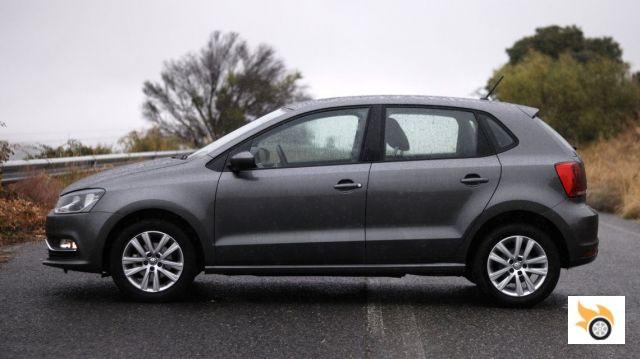
Design
The Polo is currently halfway through the life cycle of its current generation, updated in 2014. It is visually distinguished by a new bumper, with larger lower air intakes and a visual union between the headlights a little more coherent. The headlights are halogen in this case, but you could equip them entirely in LED, xenon are no longer available. There's a chrome strip running along the grille, and chrome surrounds on the fog lights (not on this model). The rear view mirrors include the side indicators.
It is 2 mm longer than the 2009 model, the rest of the dimensions are identical. There is also a three-door version (yet)
The color palette was doubled with the restyling, eight new shades for a total of 15 combinations. Starting with the base model the exterior parts match the body colour, and the roof can be optionally coloured in grey or black. It has six new alloy wheel designs, in that case it has the "Estrada" model wheels (6Jx15) with 185/60 R15 tyres and anti-theft bolts. It is part of a launch package (W07), but it should have steel rims with trims as standard.
At the rear the light clusters are new and visually everything is more horizontal and coherent. It doesn't have a badge that identifies it in terms of engine, the TSI does. It only shows "Polo" and "Bluemotion Technology". The reflective reflectors have been lowered and moved to the sides (before it seemed not to have them), according to the manufacturer is a sign of robustness. The most obvious difference between the 2009 model and the 2014 model is the area for the license plate, much more generous now. The maximum height of the hatch when deployed is two metres.
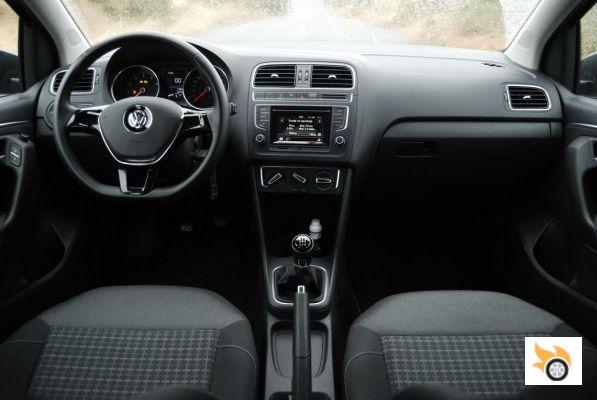
Interior
Why pay more for a Polo than for an equivalent model? The fundamental differentiating factor is the interior and its qualities. There aren't many cars in this category with a padded plastic dashboard (Advance version), cooled glovebox with delayed opening, electric windows as standard throughout the range (in the back too), leather steering wheel that feels like real leather, a perfect fit between parts, not a single noise?
Ergonomically I have no complaints, it's very easy to find a comfortable driving position. Some buttons have been repositioned, and there's a big change in the central display and infotainment system. It was the first Volkswagen to adopt the new MIB architecture, and has four models available. The one in this unit is a Composition Media, with a 6.5-inch screen, touchscreen of course. Operation is very intuitive and requires little training.
The three-spoke steering wheel is similar to that of the Golf, missing the standard buttons and has piano black inserts.
We will find a few changes: there are several elements with chrome, the dashboard is different (there are only two analog gauges), the mirror is less wide, the climate control looks better, etc.. The feeling of perceived quality is high, above what is usual for a car of this category, and it seems to have improved significantly from the previous generation (9N). It gave me the impression of aging well, and that's something I value highly in a car: being able to have it for many years without cursing creaks and rattles. I've tested cars in this segment that with less than 10,000 km already had crickets.
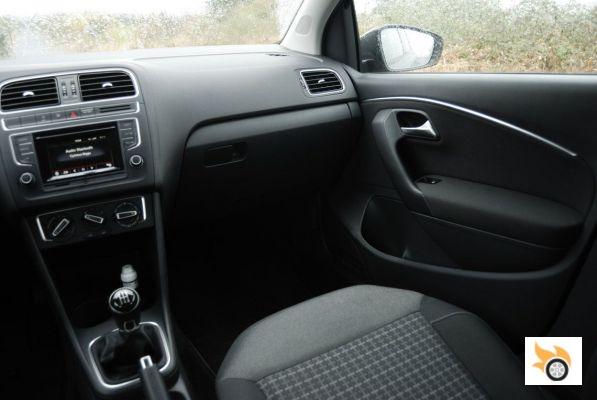
In terms of habitability is within the average of its category, it does not stand out in anything, but does not draw attention to anything bad either. Four people of 1.7 meters tall will be comfortable, and the space for the head in the back is better than in the Ibiza. The bench seat is inclined, a common trick in this category for more space. Three can ride in the back relatively comfortably, although the legroom for the fifth passenger isn't brilliant. It is certainly preferable to the Audi A1 we tested last year, also in trunk.
Its 280 liters are not the best in the segment, several rivals surpass it. The maximum capacity is 952 liters
From the basic version the trunk has lighting, split rear bench and solid tray (optionally can be rolled up). In addition, it has a double-height boot, the upper part is flush with the loading mouth and with the seats folded down. Under the lower height will be the spare wheel or puncture repair kit, as well as basic tools. It has a roof box -original accessory- with 340 liters of capacity, to get out of tight spots.
In terms of equipment, this model has programmable cruise control, ESP, Bluetooth, USB and auxiliary connectors, CD player, specific compartments (for cards, sunglasses, CD cases and pens), five headrests (the front ones with anti-whiplash system), efficient driving assistant, automatic braking if the airbags deploy, height adjustment of the seat belts... The optional equipment options are very interesting, such as the sunroof, trays for rear occupants and a very long etcetera.
Technology
The engine of the basic petrol Polo is the same as that of the Up!, both one-litre three-cylinder, non-turbocharged, with multi-point injection (MPI). The 60 and 75 hp versions have exactly the same maximum torque, 95 Nm between 3,000 and 4,300 rpm. This figure is clearly below what the 1.2 engines of the competition give. The power delivery changes at high revs, where the 75 hp is a little more lively and delivers maximum power at 6,200 RPM. The basic version has shaved the torque curve, gives 60 hp between 5,000 and 6,000 RPM.
The main change from the 2009 Polo to the current one is the new electromechanical power steering, integrated in the steering column, it is a worm gear. It's supposed to improve feel and precision, although I found it occasionally uninformative, but very pleasant to use overall. An interesting option on the new Polo, which doesn't make sense with this engine, is variable stiffness damping, a rarity in its class!
Otherwise there's not much to note about this version. In the engine bay I was struck by the engine mounts. It seemed to me that the studs that hold the engine vibrations are easy to replace when they wear out and annoying noises and vibrations start to appear. It seems very easy to access all parts of the engine, that may reduce the labor of multiple maintenance operations, corrective or periodic.
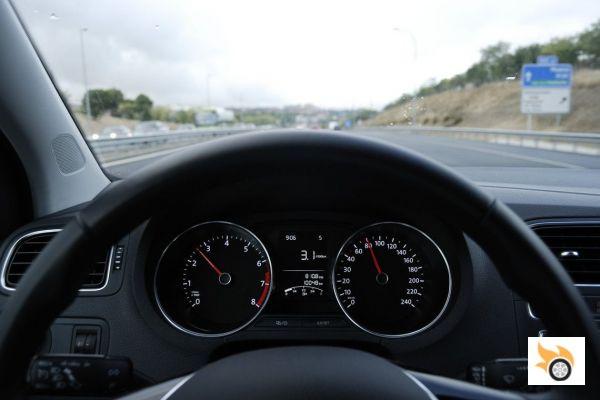
Driving
I've been known to be a sucker for three-cylinder engines, but in this case I'll take a pass. Not only is it a B-segment car, and it weighs very little (1,055 kg unladen), but I don't find it noticeably annoying in terms of noise or vibrations. I'd wager that the 1.5 of the BMW 116i rattles more. It's one of those engines that compensates for its lack of power with a very low consumption, and so low!
It has a graphical assistant that scores the way you drive and helps coach the driver to achieve maximum efficiency
It's homologated at 4.8 l/100 km, and that figure is much more credible than the turbocharged three-cylinder. In fact, it's possible to match that figure or go below it without any difficulty. It doesn't make sense to buy a diesel alternative to this engine, but it does exist, a 75 hp three-cylinder (1.4 TDI) that costs 2,150 euros more. Performance is very fair: 0-100 km/h in 14.3 seconds, a top speed of 173 km/h and recovery from 80 to 120 km/h in almost 12 seconds.
In fact, I did the recovery test in third gear, because in fourth gear it recovers badly and in fifth gear worse. It will cut fuel injection very soon after 120 km/h, so it's the right gear for overtaking on the flat or downhill! The transmission ratio is not very long, but going to 120 km/h means going at about 4,000 RPM in fifth gear, fortunately the soundproofing quality is remarkable and doesn't bother. Going over 140 km/h is already a bit noisy, normal, the engine is very high revs, over 5,000 RPM. According to our scoring system, in terms of performance it gets a fail, the sum of acceleration and recovery exceeds 20 seconds.
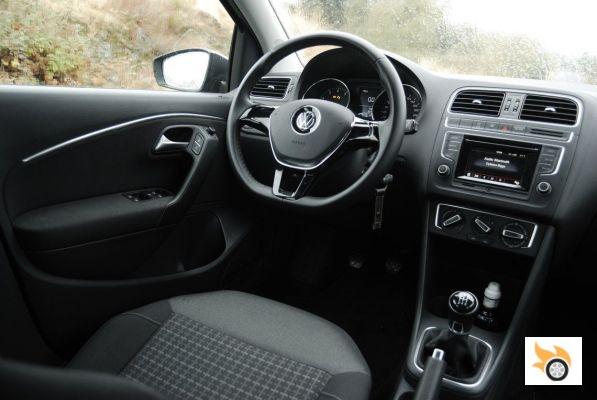
It's very pleasant to use, it's very well insulated and you don't notice that it's a three-cylinder.
OK, it's 75 hp and it's not a rocket, but if you know how to squeeze the power it has everything you need for day to day driving. At first I found it a bit heavy (believing it had 100 hp), but being aware of its real power, I found it even agile. The only thing that makes it a bit desperate is when jogging at 120-130 and another vehicle forces us to brake, gaining speed uphill makes you sweat, you have to go with your foot to the floor. It would scare me to see my telemetry one day when I was a bit short of time and I had to make it "fly", despite this circumstance, the average did not exceed 6.5 l/100 km on that trip!
It's a very austere engine, it's technically possible to do 900 km until the tank is empty, and that's 45 litres, but it can't stress us at all: we should average exactly 5 l/100 km. The on-board computer showed 4.1 l/100 km on my usual trip to the university, with a very zen driving, and without rushing. At full tank the real consumption was 5.6-5.7 l/100 km (5.3 l/100 km according to the computer), which is very little more than a Toyota Prius. Based on what I put my foot down on it, I think it's not much. I'm referring to a sometimes lively driving, with toe-tap reductions and several rides above 5,000 RPM.
The 60 hp version seems to me recommendable for those who use the car mainly in urban areas, at moderate speeds, or in areas where there are hardly any slopes. For the rest it seems to me very fair, but the good thing is that it is enough to make a reprogramming to raise it to 75 hp. According to Volkswagen there are no physical changes from one engine to another, but there are important differences in equipment, the 60 hp can only opt for the basic equipment (which is relatively generous).
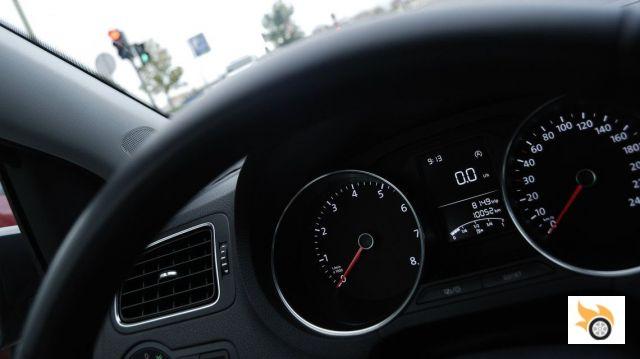
The on-board computer has three indicators: from refueling, manual initialization and automatic initialization. It gives very complete information, on the central screen of the dashboard you can know the temperature of the coolant, or how much is left for the review. For those who want to go to the workshop as little as possible, you can hardly choose better: every two years or 30,000 kilometers, and mechanically it is an almost indestructible engine. It will not give any of the problems of a diesel (injectors, EGR, turbo, flow meter, FAP, etc).
In urban areas the operation of the Stop&Start is appreciated, the stop and start of the engine is not abrupt. I've driven the car full of kids and it has enough agility to move around the city. At the beach, loaded to the top and with five occupants, you will have to have some patience. The fourth gear does not have to be used systematically at the slightest slope, in fact, I have used it very little, almost all my motorway driving, except when I wanted to gain speed, I have done it in fifth gear.
With that consumption, and with cheap maintenance, it is an ideal car for shallow pockets. It's a real "no hassle" car.
It's a good car to learn to drive, even in sporty driving. The more experience you have, the lower the fuel consumption and the better the performance. It is very difficult to be caught by a radar with this engine at an outrageous speed. And it is also difficult to get stuck, the 7 liters of reserve last about 80 kilometers according to the computer, and obviously last longer.
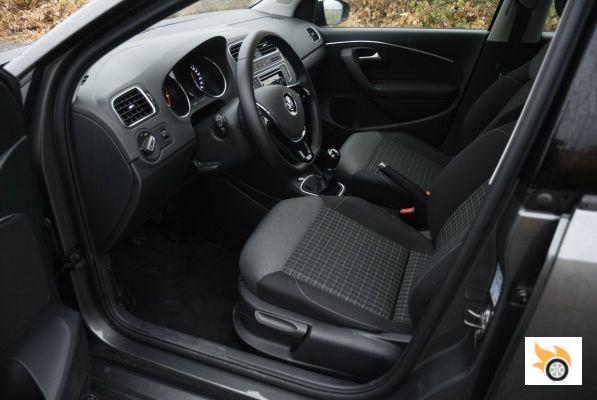
The standard suspension is soft and pleasant, although it feels a little low for sporty driving. The car becomes a bit slow to react when changing support or when touching an expansion joint at a roundabout at a high speed. It is very easy to drive, the standard stability control works a little, even if the driver is a little "pawsome". I had a lot of fun with this car, you don't need to drive a beast to have a good time.
For day to day driving, the suspension absorbs the irregularities of the terrain well, but I'm not convinced by the slow extension it has on big bumps. This is quite normal in light cars with rear torsion bar, it's not a problem specific to the Polo. The rear brakes are drum brakes, but they do their job adequately and the stopping distances are correct. Another advantage: they don't dirty the rims. Considering it's not a sporty version, I have no further complaints.
I would like to make a few additional comments. The dipped headlights can be kept on permanently. If by carelessness we get out of the car and they are left on, nothing happens, they turn off, they won't waste the battery. It has daytime running lights, but the light sensor is optional in this finish. On the other hand, the tip-tacón requires some practice, the difference in height between the brake and the accelerator is pronounced and may not come out the first time. When you get the hang of it, it makes driving more fun and the engine is better used, but I'm not saying it's essential!
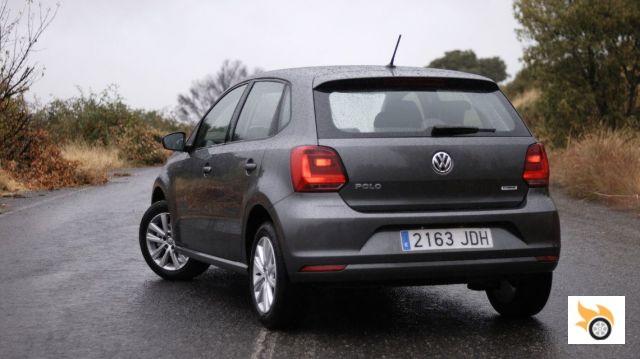
Conclusions
The Polo Advance 1.0 MPI has seemed to me, above all, a very honest car. It's not cheap, but it has quality. The Polo is manufactured in our country since the early 80s and the positioning has been rising compared to its competitors, we all remember having known a bare Polo, but now even the basic versions are generously equipped. There are cheaper ones, of course, but the difference is always noticeable.
We miss any modern security system based on camera and/or ultrasound (and in option as well).
I got to thinking that, if I needed a B-segment car, I'd like one of this type, although the price pulls back a bit. I suppose you could always look for a bargain deal with a 0 km, pick a unit with a color no one wants, or a low-run management car. It seems like a companion to be with for a long time and then make the jump to a car of more packaging. The engine, as I said, is not a missile, but with 75 hp and this weight you can not ask for more. It would have more gear with turbo, and it would also swallow more. We've asked Volkswagen for a Polo 1.0 TSI to compare, but there are no units available. Too bad. We'll check how that engine performs in the Golf, but more on that later.
So, if you want a car with very compact dimensions and a higher level of quality - without paying the extra price of an Audi A1 or a Mini - you should consider the Polo. By loosening the corresponding extras you can equip it with DSG gearbox (not for this engine), front radar with intelligent cruise control and automatic braking, fatigue detector, dual hardness suspension, steering wheel controls, rear curtain airbags, dual zone climate control, sports suspension (-15 mm height), App Connect (for high-end mobile phones)....
Can all its rivals say that? No.

























